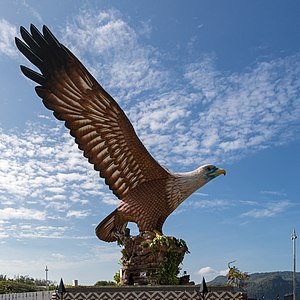
Langkawi, officially known as Langkawi the Jewel of Kedah (Malay: Langkawi Permata Kedah) is an archipelago of 104 islands in the Andaman Sea, some 30 km off the mainland coast of northwestern Malaysia. The islands are a part of the state of Kedah, which is adjacent to the Thai border. On July 15, 2008, Sultan Abdul Halim of Kedah had consented to the change of name to Langkawi Permata Kedah in conjunction with his Golden Jubilee Celebration. By far the largest of the islands is the eponymous Pulau Langkawi with a population of some 64,792, the only other inhabited island being nearby Pulau Tuba. Langkawi is also an administrative district with the town of Kuah as largest town. Langkawi is a duty-free island.
Etymology
Langkawi means island of the reddish-brown eagle in colloquial Malay.[2] The Malay word for eagle is helang - which is shortened to "lang". It was given the title of "Langkawi, the Jewel of Kedah" in 2008 by Kedah's Sultan Abdul Halim Mu'adzam Shah as part of his golden jubilee to impress on tourists that it was part of Kedah.
Geography
Langkawi, a cluster of 104 islands separated from mainland Malaysia by the Straits of Malacca, is a district of the state of Kedah in Northern Malaysia and lies approximately 51 km west of Kedah. The total land mass of the islands is 47,848hectares. The main island spans about 25 km from north to south and slightly more for east and west. The coastal areas consist of flat, alluvial plains punctuated with limestone ridges. Two-thirds of the island is dominated by forest-covered mountains, hills and natural vegetation.
The island's oldest geological formation, Gunung Matchincang, was the first part of South-East Asia to rise from the seabed in the Cambrian period more than half a billion years ago. The oldest part of the formation is observable at Teluk Datai to the north-west of the island, where the exposed outcrop consists of mainly sandstone (quartzite) in the upper parts and shale andmudstone in the lower parts of the sequence.
.
Economy
An agro-based economy of padi and rubber cultivation and fisheries is fast being overtaken by a tourism-driven economy, taking into consideration the natural, unspoiled, ecological beauty of the island and major governmental emphasis.
The Northern Corridor Economic Region (NCER) development program is a Malaysia Government initiative to accelerate economic growth in the north of Peninsular Malaysia – encompassing the states of Perlis, Kedah, Penang and the north of Perak.
The target for NCER is to achieve increased tourism receipts per visitor from MYR1,890 (US$600) in 2005 to MYR3,034 (US$963) by 2012.
Annual tourist expenditure is targeted to increase from MYR9.0 billion (US$2.86 billion) in 2005 to MYR21.8 billion (US$6.9 billion) in 2012 and MYR64.5 billion (US$20.4 billion) in 2020.[5][dead link]
Tourism
The Kilim Karst Geoforest Park (The Kilim River)On June 1, 2007, Langkawi Island was given a World Geopark status by UNESCO.[6] Three of its main conservation areas in Langkawi Geopark are Machincang Cambrian Geoforest Park, Kilim Karst Geoforest Park and Dayang Bunting Marble Geoforest park (Island of the Pregnant Maiden Lake). These three parks are the most popular tourism area within Langkawi Geopark.
This area actually consists of three river estuaries that stretch from the Kisap village approximately 10 km to Tanjung Rhu and they are all interconnected. They are rich in wildlife and tourists may see hairy nosed sea otters, brown winged kingfishers, monitor lizards and swimming macaque monkeys. Limestone, inherently porous, forms caves and there are several in the mangroves. One of Langkawi's natural beauty spots is the Pirate Lagoon just outside the river. Technically this is a collapsed cave (hong) consisting of a cave entrance from the sea emerging into a hidden lagoon with towering, limestone escarpments and smaller caves.[citation needed]
Langkawi Islands
There are two island areas: the Southern Islands, with a heavy tourist population and the islands to the north east which are more secluded without tourist traffic. Langun Island has a fresh-water lake like Pregnant Maiden Lake only without the tourists and has Sand Spit Beach on its south-facing orientation. Dendang Island next to it forms a bay popular with Langkawi sailing yacht tour operators who favour the area for its natural beauty and peace.[citation needed]
Some of the most popular beaches are Pantai Cenang, Pantai Tengah, Burau Bay, Pantai Kok, and Datai Bay. Pantai Cenang is a picturesque beach with seemingly unending stretches of fine white sand. It has numerous restaurants and bars for evening entertainment, several hosting live music and for watching the sun set. The beach is contoured by tall coconuts and casuarinas. Pantai Tengah is separated from Cenang by a small cape. It too faces the setting sun and is populated more by hotels than bars, making it less busy in the evening. Burau Bay, fringed by rocky outcrops, is the favorite place of migratory birds in Langkawi. Pantai Kok is a peaceful beach with the backdrop of limestone hills. Datai Bay has a combination of forests and sea. The milky beach is backed by lush forest.
The Langkawi Cable Car takes visitors up to the peak of Gunung Mat Chinchang, where the Langkawi Sky Bridge is located.
Tourists can enter the island via ferry from Kuala Perlis or by flight from Kuala Lumpur. AirAsia and Fireflyz provides budget connection to the island.
Transportation
The island of Langkawi can be reached by sea and air. The Langkawi Jetty Point connects the island to main destinations like Kuala Perlis,Kuala Kedah, Penang and Tamalang. There's also ferry service to Satun town and to Ko Lipe island in Thailand. The Langkawi International Airport is one of 7 international airports in Malaysia and connects the island to Kuala Lumpur, Singapore, Penang and alsoSubang. On the island, a main road runs through the whole island.
Source: Wikipedia, http://en.wikipedia.org/wiki/Langkawi


No comments:
Post a Comment